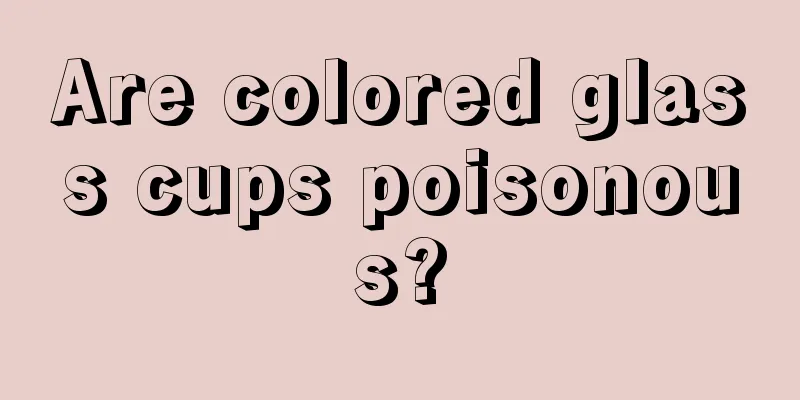Are colored glass cups poisonous?

|
Colored glass cups are quite common in our daily life. Colored glass cups are pleasing to the eye and have certain ornamental value. However, you should also be careful when drinking water from colored glass cups. Because the production process of colored glass cups is different, there may be some toxins in them. For example, some of them are added with chemicals. Such glass cups will have certain adverse effects on health, so you must learn how to identify them. It is recommended that you choose colored glass cups carefully. Because: 1. Glass itself has no color; 2. There are two possibilities for the production of colored glass: A. Natural color, the original material used to make the glass contains some minerals, which makes the glass colorful; B. Most colored glass is made by adding pigments during the processing and production process, and these pigments generally contain heavy metals. But the color cannot be used as the reason for the problem of the glass. How to identify lead-free glass? 1. Look at the label: lead-free glass generally contains potassium, and most of them are high-end handicrafts with labels on the outer packaging; while leaded glass contains lead, that is, the crystal glassware commonly seen in some supermarkets and street stalls, the lead oxide content can reach 24%. 2. Look at the color: Lead-free glass has better refractive index than traditional lead-containing crystal glass, and more perfectly displays the refractive index of metallic glass; for example, some ornaments of various shapes, crystal wine glasses, crystal lamps, etc. are made of lead-containing glass. 3. Look at the heat resistance: Glass cups can generally withstand very high temperatures, but generally have poor resistance to extreme cold and heat. Lead-free crystal glass has a high expansion coefficient and is less resistant to extreme heat and cold. If you use boiling water to make tea in a particularly cold lead-free glass, it is prone to bursting. 4. Weigh the weight: Leaded crystal glass products are slightly heavier than lead-free crystal glass products. 5. Listen to the sound: The sound of lead-free glass is more pleasant than the metallic sound of lead-containing crystal glass, and it is known as the "musical" cup. 6. Look at toughness: lead-free glass is more resilient and impact-resistant than lead-containing crystal glass. Precautions for using the glass 1. When using the glass for the first time, please wash it with a soft cloth and warm water. 2. If the inner tank is heavily stained with tea after long-term use, pour a small amount of 84 disinfectant into it, soak it for a while, then rinse it with clean water to make it as bright as new. Please clean the outer surface directly with mild detergent and soft cloth. Each part must be cleaned after each use. 3. Please wash with a mild neutral detergent. To avoid scratches on the cup that affect its appearance, do not wipe the cup with a rough metal wire ball. When filling the glass with boiling water, do not fill the water level too full to avoid overflow when making tea. Do not heat the glass directly in high-temperature appliances such as microwave ovens and disinfection cabinets to avoid deformation of the cup and affect the use effect. The cup lid can only be unscrewed clockwise (turn it with your right hand from left to right towards yourself), otherwise it may cause burns. Children should use it with caution to prevent the product from breaking or scalding themselves. 4. Avoid using the product in an environment with large temperature differences. Usually, a temperature difference of more than 80 degrees will cause the container to expand and contract violently, which may easily lead to bursting. Unless otherwise specified, please try to avoid using containers to hold water that is too hot or too cold. 5. Before pouring in hot water, you can pour in a small amount first and shake the container to allow the hot water to fully contact it to achieve the purpose of preheating the container. Then pour in hot water to prevent the container from bursting due to excessive temperature difference. |
<<: Is borosilicate glass toxic?
>>: Can glass cups be frozen in the refrigerator?
Recommend
Treatment of gingivitis
Gingivitis is a common inflammation, which mainly...
What are the applications of potassium persulfate tablets in aquaculture
Now many aquaculture workers are using potassium ...
Does it hurt to correct your teeth with invisible braces?
Nowadays, many people's teeth are not very st...
Is garlic effective in preventing stomach cancer?
Onions and garlic are the golden condiments in Ch...
How can I remove stubborn stains?
If you don't pay attention during work or lif...
Introduction to disease prevention knowledge in spring
I believe everyone knows that spring is a season ...
What are the advantages of interventional treatment for liver cancer? 7 advantages of interventional treatment for liver cancer
Interventional treatment of liver cancer refers t...
The difference between Koukouho and Hami melon
There are many types of Hami melons, among which ...
What should I do if my ears are bleeding?
The ears are our most important organs. When peop...
What are the ways to prevent lung cancer? Five ways to prevent lung cancer from happening
Lung cancer is a common malignant tumor, so the p...
What are the treatment methods for kidney cancer? Generally, these 4 methods are used.
Surgery is a common method for treating kidney ca...
Tips for treating cold and painful knees
The older people get, the more likely they are to...
How is breast fibroid inherited
In fact, multiple breast fibroids are relatively ...
Is malignant teratoma life-threatening?
Yes, malignant teratomas are aggressive and poten...
Why is there so much flesh on the front of the thigh
The legs are the part that bears the most weight ...









